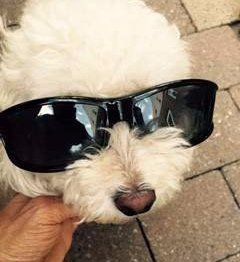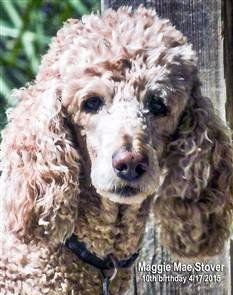Call us: 555-555-5555
Summer

Poodle Summer Care
Overview
While many people think of summer as one of the most enjoyable seasons (and it certainly can be), the hot weather and all that is associated with it means that some changes should take place in regard to your Poodle’s care.
While summertime officially begins at the summer solstice (June 20 or 21) and ends at the autumn equinox (September 20), hot weather, glaring sun and other summer-related elements can come into play far outside those few months.
Additionally, there will be plenty of pet owners who live in a location that has year-round summer-like weather.
This section will cover:
- Exercising your Poodle in the summer
- What to do if a Poodle gets heat stress or stroke
- Summertime protection of the paws, skin and nose
- Tips to help a Poodle stay cool and comfortable
- Summer water requirements
- Dealing with insects
- Avoiding hot weather motion sickness


Amber, at 12 weeks old
Photo courtesy of Tina
Exercising Your Poodle in the Summer
Regular exercise plays a huge role in both maintaining a Poodle’s health and preventing a host of illness.
Daily walks can also allow a dog to release pent-up energy which can lead to better behavior back in the house, is a good way to work towards socialization skills and is your chance to work on heeling.
However, it’s common for owners to find it more difficult to exercise their Poodle when it’s hot outside. Since cutting back on walks can be quite detrimental, let’s look at ways you can safely exercise your Poodle in the summer.
1) Timing.
Aim for 2 walks per day, each with a duration of at least 20 minutes. Whether you have a toy, miniature or standard Poodle, you will want to go at a pace that is brisk for your Poodle.
It is best to schedule these walks for early in the morning and later in the evening as the sun readies to set, but still allows enough light to see; this will allow you to avoid the hottest parts of the day.
2) Breaks.
No matter the temperature, make sure that your Poodle drinks before you head out. You’ll also want to bring along water. At the halfway mark, plan to rest in a shady area if possible to allow your Poodle to have a break and rehydrate.
A canine water travel container is an easy way to take along water, as it is one piece that serves as both container and bowl (the cover is the bowl).
The H2O4K9 Dog Water Bottle and Travel Bowl
 is a great choice, this is made of stainless steel, is super easy to tote around, and comes in 4 different colors.
is a great choice, this is made of stainless steel, is super easy to tote around, and comes in 4 different colors.
3) Reassess the route.
If you have more than one option regarding which roads you will be taking your Poodle, scout out possible routes ahead of time.
When walking your Poodle in the summer, it’s best to choose shaded sidewalks with a comfortable ‘break area’ such as a soft patch of grass under a large tree.
4) Prevent paw damage. Even if you walk in the shade and during the coolest parts of the day, you’ll want to ensure that the walking surfaces cannot cause burns and/or damage to your Poodle’s paws (more info ahead).
5) Know the signs of heat stroke.
Some dogs are much more sensitive to this than others. For Poodles, it can be a matter of slightly less water intake at home, a bout of activity indoors that the owner did not witness and then a walk that can lead to heat stress that takes the owner by surprise.
In other cases, staying outside for long periods of time, even in the shade, can take its toll after a certain amount of time. You’ll want to be very familiar with the symptoms of heat stress, so that you can take fast action before it develops into heat stroke.
Prevention and Identification of a Poodle with Heat Stress or Stroke
While some use these terms interchangeably, there is a difference between these two though both can be categorized under heat exhaustion, which is medically known as hyperthermia.
Both occur if a dog’s body is struggling to cool off and maintain proper body temperature. This can happen within a matter of minutes, leaving owners caught off guard. Intervening quickly is very important.
- Heat stress happens first – A dog’s body will start to become overwhelmed in dealing with hot weather. The Poodle’s normal body temperature of 101 to 102.5 degrees F will raise to 103 Fahrenheit.
- Heat stroke
– Without immediately treatment, stress can spiral very fast into heat stroke. The dog’s internal temp is now 106 or higher. At this point, the condition is life-threatening with swelling of the brain, kidney failure and abnormal clotting of blood leading to a complete shutdown of the body.
Signs
– Note that signs can occur while a Poodle is active outside in the summer or right afterwards; and this is vital to know since some owners assume that as soon as the dog comes back inside, the danger is averted. Symptoms of both conditions include:
- Red gums (we recommend taking note of the normal color of your Poodle’s gums, so that in the summer you can quickly assess if the color is deeper and darker than normal)
- Panting (while dogs pant to cool off, this will be heavy or distressed panting)
- Glazed eyes
- Drooling
- Rapid heartbeat
- Decreased urination
- Excessive thirst
Without treatment, this can then lead to trouble walking, confusion, collapse, coma and eventual death.


Nutmeg,
Photo courtesy of Deborah Poma
What to do:
If you suspect that your Poodle is becoming overwhelmed in the summer heat, you will want to:
1. Seek shelter in a cooler location.
If you have a toy or miniature Poodle
or a standard Poodle puppy, carry your dog is possible. If you are outside and not able to reach air-conditioned shelter, seek a cooler, shady area.
2. Cool down the Poodle’s body. It’s important to do this, but not too rapidly. So, you’ll want to avoid ice. Do, however, soak towels in cool water and place these over your Poodle’s body. If possible, use fans to displace their air around your dog. Alternatively, you may place your Poodle in a shallow bath with cool (not cold) water.
If you are outside and unable to make it back to the house, the water you brought for your Poodle to drink will come in handy; use half to soak his body and half for him to drink. In addition, evaporated cooling can be done by patting the paw pads, groin and under the forelegs with isopropyl alcohol.
3. Keep checking temperature. Most veterinarians suggest not moving the dog into the car to reach a clinic until the dog’s temp has gone back down to 103 F. Be prepared in this regard by having a canine thermometer both in your house and in a small first aid kit if you will be out and about with your Poodle in the summertime.
4. Veterinary treatment
– You should bring your Poodle to the vet after an episode of heat stress, even if you are able to treat your Poodle at home and stabilize him since enduring such an event puts an extreme amount of stress on the body. And of course, veterinary treatment is needed if the dog entered heat stroke. Damage to organs including the brain and kidneys will need to checked for. The dog may need oxygen supplementation and IV intervention to treat dehydration. Please remember that this is a life-threatening condition.
Protecting Your Poodle’s Paws in the Summer
The paws, beyond doubt, are the area on a dog’s body most at risk for injury during the summertime.
Since we humans walk outside with shoes on, it’s easy to forget just how hot and dangerous outside walking surfaces can be for our Poodles.
Did you know that a sidewalk surface can reach 125 F on a day that is just 77F ? Or that pavement can soar to 140 F on an 87-degree day? These are serious temps (an egg can start to fry outside at 144 F) and anything over 120 F is unsafe for your Poodle to walk on.
The 2 issues
you’ll want to prevent are immediate burns and gradual damage. If you continually walk your Poodle outside in the summer without proper paw protection, you may not notice an issue right away.
However, heat coming off of walking surfaces can gradually damage paw pads, which leads to dryness; this then can lead to eventual peeling, cracking and sores.
What to do:
Use a quality paw wax like Musher's Secret Pet Paw Wax
 . This one does not block paw perspiration yet does add a layer of protection to the paw pad skin. It is fast absorbing and lasts for 3 to 4 days for each application.
. This one does not block paw perspiration yet does add a layer of protection to the paw pad skin. It is fast absorbing and lasts for 3 to 4 days for each application.


Bambi, at 6 years old
Photo courtesy of Veronica Philogene from Melbourne Australia.
Preventing Dry Skin and Sunburn in the Summer
With breeds like the Poodle, taking steps to prevent dry skin issues and sunburn is part of summer care. With a single layer of hair, the coat simply does not offer full protection from the sun’s damaging rays.
Over the course of the season, the accumulated exposure to the sun can lead to a drying of the skin. This can lead to peeling and itchiness, often resulting in the Poodle chewing at the paws
and other dry areas most accessible to him. When outside in the sun for several hours, sunburn is a risk as well.
What to do:
Protect the skin and coat with a quality leave-in spray.
A good leave-in also helps protect the coat from static, contact friction and split ends, which leads to a healthy coat, so we do recommend this year-round.
Furthermore, this is a great method to help a Poodle stay smelling fresh and clean.
Consider using one with sunscreen like Chris Christensen Ice on Ice Conditioner with Sunscreen .
.
In the summer, spritz the coat every 3 days or so. Be sure to keep up with a bath every 3 weeks, as this offers a ‘clean slate’ in which excess body oils and product buildup are washed off.
For full-day outings in which you know your Poodle will be outside for a good amount of time, additional sunscreen applied to the belly (surfaces can reflect up onto a dog’s belly) is a good idea as well.
A great one to try is Epi-Pet Sun Protector Spray for Pets ; this is the only FDA approved sun block for pets and has 30-40 SPF protection.
; this is the only FDA approved sun block for pets and has 30-40 SPF protection.
Protecting a Poodle’s Nose in the Summer
There are 2 elements to keep in mind. A moderate amount of sunlight on the nose is beneficial for dogs, without this a Poodle’s nose can start to lose its dark pigmentation.
In fact, developing pink spots on the nose are often due to: a lack of sunlight and/or eating from a plastic bowl.
This said, too much sun exposure can lead to a very dry nose. Once dry, the nose leather may start to peel. And once peeling develops, cracks are not too far away.
Therefore, using a canine nose butter once or twice per week to help a Poodle’s nose retain proper moisture and treat any dryness is a beneficial aspect to summer care. And if you will be spending the day outside with your Poodle, do protect the nose in advance with the nose balm. Since it is natural for dogs to lick their noses, look for one that absorbs quickly and is made with all natural ingredients.
Below are our top recommendations for coat, skin, paw, and nose protection for your Poodle.
If you do not see the images, try a refresh. And on mobile, you may need to turn your screen horizontal to see all 4. Next, we will cover great tips for helping to keep a Poodle comfortable and cool when it's hot out.
Helping a Poodle Stay Comfortable in the Summer
To shave or not to shave a Poodle in the summer – Once of the great things about this breed is the versatility with the coat. It can be grown in nice and thick, shaved closely or kept somewhere in between. And many owners wonder if they should have their Poodle shaved for the summer. There are pros and cons to this.
While a close trim is easy to take care of and it can make owners feel better that their dog has a ‘summer haircut’, since this breed has a single layer of hair, which is not as dense as fur, a cut is not actually needed. In fact, do be careful to not have it shaved too close, as this increases the chances for sunburn (and just like us humans, sunburn increase the chances of cancer).
Assess your Poodle’s indoor area
– No doubt your Poodle has some favorite spots in the house and if left home alone, hopefully has a nice canine playpen or gated off area. And while the set-up may appear to be super comfortable and safe, there are 2 elements to reassess as summer comes around.
First, you’ll want to see if the AC is blowing too directly into the spot. Direct blasts of cold air can quickly lead to discomfort. The other issue is any sunlight streaming in. With the angle of the sun quite different from winter
to summer, you’ll want to see if there are overly strong rays shining in at the times that the Poodle is home by himself.
And the time of the day is important here; if you are normally away from work at 12 noon and on weekends your Poodle is not in that area, you won’t know about this element unless you purposely take note.
Helping a Poodle Stay Cool in the Summer
1. Cooling mats
are a great method for dogs to beat the summer heat. The best ones are those that are self-cooling.
These are made from a special gel that is activated when the dog sits or lies down. They never need to be plugged in or cooled in the fridge. They actually do not emit any cold, rather they absorb a dog’s excess body heat. You may find that your Poodle enjoys the cooling sensation both indoors and when outside.
And it’s a great item to bring along if you’re taking your Poodle out to a barbecue, the beach or other sunny, hot location. Some owners like to place a small one inside their dog’s stroller, which brings us to the next item.
2. Canine strollers
are fantastic for miniature and toy Poodles, if you’re planning on bringing your Poodle to an event in which there will be lots of walking. They allow the dog a great view, while remaining comfortable in the shade. And as mentioned, if it will be very hot, you can place a small sized cooling mat in the bottom of the stroller.
3. Canine cooling vests
are another good method to help a Poodle handle the heat of summer. Look for a light-weight vest that soaks up water to then keep a dog feeling comfortable. These are great if your Poodle will be participating in an outdoor activity for 1 hour or more.


Gina, at 6 years old
Photo courtesy of Ann Marie
4. Water entertainment
shouldn’t be overlooked. While Poodles are naturally good swimmers and may love to join you in a pool, other fun options are portable kiddie pools and sprinklers, both which are rather quick to set up in your yard but can also be brought along when visiting friends and families. While this is often enjoyable for dogs of all ages, particularly senior Poodles
tend to really enjoy the sensation of just lying down in 1 or 2 inches of water in a small inflatable or plastic kiddie pool. Do place this in the shade.
5. Snacks and treats
can be a healthy part of summer care for a Poodle. Fruits like watermelon, blueberries, raspberries and strawberries have a high water content, which can really help keep a Poodle hydrated. And these make for great snacks any time due to low calories that deliver tons of vitamin and antioxidants. These can also be frozen to provide a cool treat and these is great for teething puppies as well. As with most things, moderation is key.
Below are our top recommendations to help keep a Poodle cool in the summer.
If you do not see the images, try a refresh. And on mobile, you may need to turn your screen horizontal to see all 4. Next, we talk about the importance of proper water intake.
Keeping a Poodle Hydrated in the Summer
The risk of dehydration soars when summertime comes around. This is because the hot weather causes a dog to pant more, which in turn lead to a quicker water loss via water droplets in his breath. Even with water available, some dogs do not properly self-regulate. Water requirements may rise as much as 20% when it’s hot outside.
Just a 2% drop in normal water levels can lead to physical issues like dry skin and brittle nails, health issues such as headaches and mood changes
including trouble focusing.
Once you reach a 5% drop, this can become a severe issue of dehydration.
Signs include sunken in eyes, lethargy, decreased appetite, dizziness and increased heart rate. Decreased rate of blood capillary refill time is also a sign; you can test this by pressing a fingertip onto your Poodle’s gums and releasing. You will see a spot on the gum that is paler in color. Count to see how long it takes for it to return to its natural color. If it takes more than a count of two full seconds, this points to dehydration.
What to do:
You’ll want to encourage your Poodle to drink a bit more in the summer:
1.
Employ the use of a canine watering fountain. These are good at attracting a dog to them via the noise of the flowing water.
2.
If you stick with a bowl, be sure to use a stainless steel bowl (these are more sanitary than plastic), clean it daily and refill it often with cool, clean water. Dogs may resist drinking enough if the water is stale and/or has food particles in it.
3.
Offer water-packed fruit, as mentioned earlier or mix some into meals for added hydration.
4.
When exercising your Poodle
in the summer, always bring along water and stop to offer it.


Maggie Mae, Photo courtesy of Deb Stover
Summertime Insects
As with all seasons, there is always something to be on guard with and keeping insects away from your Poodle is high on the list. The 3 main concerns are:
1. Mosquitoes
can spread heartworm disease. Aside from this, a Poodle can be allergic to mosquito bites, just 1 or 2 can cause moderate swelling and severe itching.
2. Fleas
are a concern year-round, but more so in the summer. It’s important to use a flea repellent, since these are notorious for transferring from one dog to another. Any dog within 6 feet of your Poodle is a possible risk.
3. Tick
population is at an all-time high in the summer. Your Poodle is most at risk if walking through tall grasses, but can also be found in shrubbery and piles of leaves, etc. Ticks carry disease including Lyme disease (this may be avoided if the tick is removed within 24 hours), Ehrlichiosis, Rocky Mountain spotted fever, Anaplasmosis and Babesiosis.
When you are protecting your Poodle from fleas and ticks, choose your products carefully. Stay away from any that contain Tetrachlorvinphos or propoxur, as these can cause dogs to become sick with diarrhea, vomiting, eye discharge and can even cause breathing difficulties.
No doubt you want to stay away from chemicals as much as possible.
First,
check the heartworm prevention that you are using for your Poodle; many already work to repel fleas.
Then, consider opting for an all-natural product that works on fleas, ticks, and/or mosquitoes.
One good choice is Dr. GreenPet All Natural Flea and Tick Prevention and Control Spray ; this is a 100% all-natural spray (used about every 1 to 2 weeks) that uses cedar, clove, peppermint, and cinnamon oil to repel fleas and ticks.
; this is a 100% all-natural spray (used about every 1 to 2 weeks) that uses cedar, clove, peppermint, and cinnamon oil to repel fleas and ticks.
And if you're looking for a no-chemical option that works on all 3 pests (fleas, ticks, and mosquitoes) Curealia's All-Natural Insect Repellent for Dogs
 is a fantastic option.
is a fantastic option.
This is an organic balm that contains olive oil, bees wax, shea butter, lavender, cedarwood, rosewood, and patchouli (a type of mint leaf).
You just take a small pea-sized amount, rub it between your palms to make the balm melt, and then apply it to your Poodle's upper back and neck.
Driving in the Summer with Your Poodle
Many owners find that their Poodle has a higher intolerance for the car in the summer. Luckily, following just a few guidelines can remedy this.
1. Prepare the car.
If you place your Poodle in the car with you and then turn on the AC, it may be too late to stop motion sickness. Avoid this by rolling down windows to allow heat to escape and then running the car with the AC long enough for it to be cool when you place your Poodle inside.
2. Use both AC and fresh air.
Most dogs do best with a combination of these two. While the air conditioner is needed, a bit of fresh air will aid in preventing upset stomach
and nausea.
3. Always use a canine car seat or restraint.
It is recommended to have a booster car seat for a toy Poodle . This will allow the puppy or dog to be raised enough to gain line-of-sight. Miniatures can do well with seats or belt-restraints and standards should be safely secured with a harness seat belt.
No matter what using a car seat or restraint
will keep your Poodle safe and help prevent motion sickness.
4. Sun glare shades (mostly marketed to prevent glare to babies and young children) can be very helpful for dogs, particularly toy Poodles. Those made of mesh allow for viewing while blocking the sun’s rays.
Some of the summer care items that we've covered in this last section are below.
This includes the canine water fountain, travel container, and no-chemical options for summer insects (can be used all year-round as well).
If you do not see the images, try a refresh. And on mobile, you may need to turn your screen horizontal to see all 4.
Are you a Member Yet?
Become a Member -Join for free to receive a friendly reminder when we add a new page of helpful information to the site.
You will also be able to suggest a topic for us to write about, we always look to Member suggestions. * If you are already a Member, just reply to any newsletter with your idea.
See Also:
Poodle Winter Care
- Caring for a Poodle can also be rather challenging in the winter, with harsh cold weather, dry air and snow packed ground. Read some helpful tips to keep your Poodle happy during the winter season.
Poodle Smells and Odors
- Whether its a certain part of the body that's emitting an odd odor, hard to pinpoint or even occurring right after giving a bath, this will take you through all possible causes.
AllPoodleInfo.com. All rights reserved.
| Privacy Policy
|
We are a participant in the Amazon Services LLC Associates Program, an affiliate advertising program designed to provide a means for us to earn fees by linking to Amazon.com and affiliated sites.
